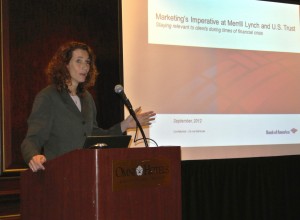Social media as practiced by Brittney Castro, Cathy Curtis, and Jeff Rose
![]() Financial advisors can win new clients from social media. Here are some of the highlights of what I heard from Brittney Castro, Cathy Curtis, and Jeff Rose in a social media panel moderated by Michael Kitces at FPA Experience in San Antonio in October 2012.
Financial advisors can win new clients from social media. Here are some of the highlights of what I heard from Brittney Castro, Cathy Curtis, and Jeff Rose in a social media panel moderated by Michael Kitces at FPA Experience in San Antonio in October 2012.
Start conversations with prospects
Social media is an inexpensive marketing tool that allows you to connect with people whom you might never have met otherwise. Ideally it means you go to where your niche market is, start a conversation, and hear what your prospects want to learn about, as Castro suggested. Your ideal social media platform will be a function of what you and your target audience prefer.
Castro, Curtis, and Rose say you don’t need to spend tons of time on social media. However, they enjoy social media, so they invest heavily in it. Curtis said she spends 10%-15% of her work hours on social media, but that doesn’t include her time during the rest of the week. Castro said “I love marketing,” so she spends 40%-50% of her time on it, plus she goes out to network face-to-face and tweets about it. Rose spends 20-30 hours a week on marketing, including social media, newsletter, and blog. “It’s almost like a second job,” he said.
Social media and blogs work well together
Blogs work well as a destination to which you send your social media friends. Rose contrasted a static website with a blog. The website says “This is my firm and this is how great I am,” while a blog shows who you are, your personality, and your knowledge. It also offers a community for interactions. Plus, the blog is where Rose captures people as leads.
Don’t drive prospects to a web page where there’s no activity, said Rose,”It’s like the Twilight Zone.” However, a Facebook page might offer enough interaction, he added.
Financial advisors are winning new clients
Curtis, Rose, and Castro have all won clients through social media and online searches. The social media and search are related because social media activity boosts your visibility in online searches. Curtis gets more new clients through online searches than referrals. Prospects often say something like “I love your website. I found you on Google.”
Rose’s client with the most assets also found him online, through a search for “certified financial planner Illinois.” At that point he’d been active in social media for six months without any direct financial benefits. You can’t expect immediate results from social media.
Twitter has also paid off for Curtis, who has built a community of women through tweets. “Almost every one of them has asked me to become their advisor,” she said.
Some people with money look for advisors on the internet. One such client pulls in $1 million a year in income. However, these wealthy clients may be on the younger side. Castro works with women in their thirties and forties who are accumulators.
Social media’s 80-20 rule
Castro’s final tip was to spend at least 80% of your social media activity “providing value.” Twenty percent or less should be promoting yourself or your services. “The less you talk about what you do, the better it is,” Castro said.
Curtis agreed with Castro’s closing tips, mentioning that her social media activity focuses more on food than finance. “Don’t be afraid to be who you are. People hire people they like,” Curtis said.
Rose said, “So many advisor bios look alike. Social media helps you to show your personality.”
Moderator Michael Kitces said, “The leads we get off social media are the warmest leads we get because they know us.” That’s a particularly intriguing comment.
What about YOU?
How is social media working for you? Also, do you have any advice for the advisor who told me that he tried social media for 18 months with no results? Please leave comments.



